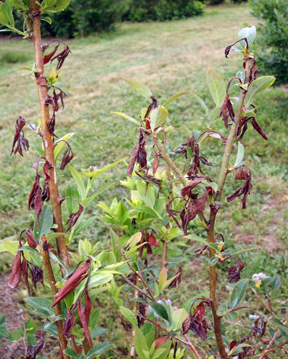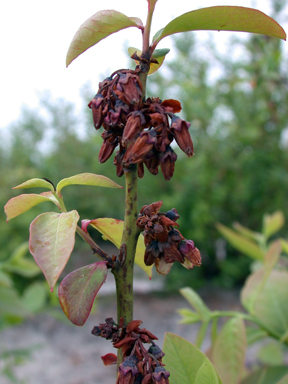Update on 2010 statewide survey for blueberry scorch and shock diseases
Editor’s note: This article is from the archives of the MSU Crop Advisory Team Alerts. Check the label of any pesticide referenced to ensure your use is included.
The 2010 statewide survey by the Michigan Department of Agriculture (MDA) for blueberry shock and blueberry scorch diseases is currently ongoing. Blueberry shock and blueberry scorch are caused by specific plant viruses, which are detrimental to blueberry plants but are not harmful to people. The MDA is randomly testing plants by leaf sampling on Michigan blueberry farms of growers who sign up for the survey. Plants do not have to be symptomatic. However, if plants are showing suspicious symptoms, e.g., sudden death of blossoms or young shoots on isolated plants, they will be preferentially sampled. Up to now, more than 8,000 samples have been tested out of a total of 35,000 samples planned. Testing is free and on a voluntary basis.
Unfortunately, the first two weeks of sampling revealed three separate sites testing positive for blueberry scorch, including a location where the disease was found last year. This suggests that some spread may have taken place by aphids (positive farms should follow a good aphid control program). In addition, it appears that scorch is not confined to the "Legacy" variety as we had hoped was the case in 2009. The virus has also been found in "Hannah’s Choice." Follow-up at the positive sites is on-going, and survey crews will continue to move forward with the survey as planned. Blueberry shock virus, the virus that was found at the Trevor Nichols Research Complex last year and subsequently eradicated from the site, has not been detected anywhere at this point. Blueberry shock virus is pollen-transmitted.
Growers should not be fearful of participating in the survey, as we do not expect these viruses to be widespread and most of the time the samples will be negative. Some people might take the attitude that ignorance is bliss, but no grower should want to have either of these viruses on their farm as they can spread and cause widespread damage on the farm as well as put the entire blueberry industry in Michigan at risk. Since blueberry scorch is aphid transmitted (relatively short-distance), if any removal is recommended, it would likely be limited to affected rows with follow-up monitoring in subsequent years.
If you become aware of fields with symptomatic plants or want a general screen of fields on your farm, please contact MDA as follows to assure the farm is included in the survey. Growers in Berrien, Van Buren and Allegan counties can contact Crew Leader Becky Madsen at (517) 599-6716 or Regional Supervisor Mike Hansen at (269) 429-0669. Growers in Ottawa, Muskegon, Oceana, Mason or Kent counties can contact Regional Supervisor Jeff Zimmer at (616) 866-1486. Growers in other parts of the state should contact Abigail Eaton at (517) 241-3933. Please note that the survey is being extended through July 16, 2010 (it was previously scheduled to be completed by June 25, 2010).



 Print
Print Email
Email





